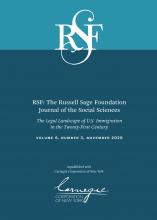Research Article
Open Access
Do Employer-Sponsored Immigrants Fare Better in Labor Markets Than Family-Sponsored Immigrants?
Julia Gelatt
RSF: The Russell Sage Foundation Journal of the Social Sciences November 2020, 6 (3) 70-93; DOI: https://doi.org/10.7758/RSF.2020.6.3.04
Julia Gelatt
aSenior policy analyst at the Migration Policy Institute, Washington, D.C., United States

REFERENCES
- ↵
- Batalova, Jeanne, and
- Michael Fix
- ↵
- Batalova, Jeanne, and
- Michael Fix
- ↵
- Batalova, Jeanne,
- Michael Fix, and
- James D. Bachmeier
- ↵
- Citizenship and Immigration Canada
- ↵
- ↵
- Jasso, Guillermina,
- Douglas S. Massey,
- Mark R. Rosenzweig, and
- James P. Smith
- ↵
- Jasso, Guillermina,
- Douglas S. Massey,
- Mark R. Rosenzweig, and
- James P. Smith
- ↵
- ↵
- ↵
- Massey, Douglas S.,
- Guillermina Jasso, and
- Monica Espinoza
- ↵
- ↵
- Office of Immigration Statistics (OIS)
- ↵
- Office of Immigration Statistics (OIS)
- ↵
- Schwabish, Jonathan A
- ↵
- Stoops, Nicole
- ↵
- Treas, Judith, and
- Shampa Mazumdar
- U.S. Department of Labor, Employment and Training Administration
- ↵
- Vincenza Desiderio, Maria, and
- Kate Hooper
In this issue
Do Employer-Sponsored Immigrants Fare Better in Labor Markets Than Family-Sponsored Immigrants?
Julia Gelatt
RSF: The Russell Sage Foundation Journal of the Social Sciences Nov 2020, 6 (3) 70-93; DOI: 10.7758/RSF.2020.6.3.04
Jump to section
Related Articles
- No related articles found.





